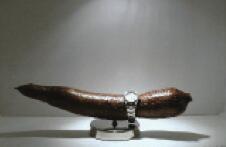Alonso Mateo
Kavachnina Contemporary, Miami
José Luis Alonso Mateo (1964, Havana) has focused his works for several years on the analysis of the rites and symbols of power, the high classes, aristocracy and royalty hence perhaps the reason for his being dubbed El Conde (the Count), as he is known among friends and colleagues, a nickname highlighted by an appearance and manners that might at times be perceived as a perpetual complementary performance for his production of objects. With ambiguous irony, Alonso Mateo’s gaze has examined environments and phenomena inherent in the purchasing power of the high classes, such as jewels, haute couture, or the genetic problems typical of royal families resulting from the practice of endogamy for the sake of preserving a supposed purity of lineage, which he rendered in his previous exhibition through Imperial style furniture that showed certain “congenital” deformations.

In “Fishing landscapes”, his new solo show at Kavachnina Contemporary, Alonso Mateo features a group of installations and sculptures that focus his refined and caustic humor mainly on sports surrounded by a certain class glamour, such as golf or sport fishing the installation after which the show is named consists of a group of seascapes on canvas that seem to have been acquired in garage sales or second hand stores, one of which has been pierced by a fish hook, the nylon line to which it is attached leading to a fishing rod hanging on the wall in another angle of the room, a piece that conveys a sarcastic commentary on the popular tendency to imitate the taste of the upper classes in matters related to aesthetics and sports. Another work graphically illustrates a perfect golf swing by inserting dozens of golf clubs on a circular support; in this case, he took a photographic sequence as reference. Likewise, a baseball bat finely lacquered with a cabinetmaker’s varnish, shows a deformity on its top end which transforms it into the arm of the batter, which in turn is actually the arm of a chair in a style reminiscent of his previous period and this automatically transforms it into a cricket bat. The only work that is not related to sports and even thus appears to be the “star of the game” is the sculpture installation Cassava with Rolex, in which the artist resumes at a different level the theme of jewels, reproducing on this occasion a jeweler’s shop window exhibiting food inserted in the hand of the valued Swiss watch. After smiling, we continue trying to guess if the Cassava and the watch are as real as Hirst’s shark.





